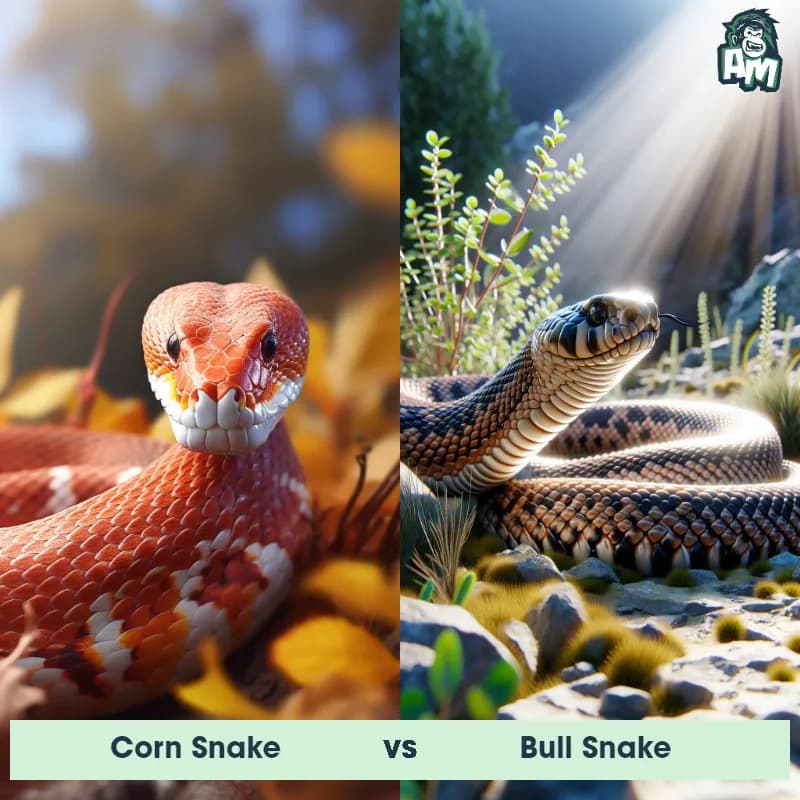Corn Snake vs Bull SnakeSee Who Wins

Ladies and gentlemen, welcome to this thrilling matchup between a Corn Snake and a Bull Snake. Both snakes have entered the arena with focused gazes, ready to showcase their skills and claim victory. Let the battle begin!
Contender 1: Corn Snake
The Corn Snake, also known as the red rat snake, is a non-venomous species of snake that is native to North America. They are slender and can grow up to 6 feet in length, with a distinctive pattern of orange, brown, and black scales. Corn snakes are known for their docile nature and are popular pets among snake enthusiasts. They are also excellent climbers and can be found in a variety of habitats, including forests, fields, and rocky areas.
Fun Fact: Corn snakes are excellent escape artists and can squeeze through small openings, such as gaps in cages or loose vents, making it important for owners to secure their enclosures properly.
Contender 2: Bull Snake
The Bull Snake, scientifically known as Pituophis catenifer, is a nonvenomous snake species found in North America. It is known for its large size, reaching an average length of 4-6 feet, with some individuals growing up to 8 feet long. Bull Snakes have an elongated and muscular body, covered in smooth scales, which can vary in color from yellowish-brown to tan. They have a series of dark blotches or saddles along their back, with a pale yellow or white belly. The head is triangular in shape and they possess large eyes with round pupils. Bull Snakes are known for their incredible climbing abilities and are skilled at burrowing. They are opportunistic feeders, consuming a variety of prey such as rodents, birds, frogs, and lizards.
![[object Object] Gif](https://tenor.com/view/bullsnake-rattlesnake-snake-strike-hissing-mimic-gif-17072855.gif)
Fun Fact: One interesting fact about Bull Snakes is that they are excellent mimics and have the ability to imitate the sound of a rattlesnake by rapidly vibrating their tail against dry vegetation, leading potential predators to believe they are facing a venomous snake and ultimately deterring them.
Matchup Stats
| Corn Snake | Bull Snake | |
|---|---|---|
| Size | Up to 6 feet (1.8 meters) | 4-6 feet (1.2-1.8 meters) |
| Weight | Up to 2.5 pounds (1.1 kilograms) | 2-6 pounds (0.9-2.7 kilograms) |
| Speed | Speed: 5 mph (8 km/hr) | 8mph (13km/h) |
| Key Strength | Constricting ability | Constriction ability |
| Biggest Weakness | Lack of venom | Lack of venom |
Current Votes
Corn Snake vs Bull Snake
See Who Wins
View More Matches
Looking For More?
Similar Matches
Scientific Stats
| Corn Snake | Bull Snake | |
|---|---|---|
| Scientific Name | Pantherophis guttatus | Pituophis catenifer |
| Family | Colubridae | Colubridae |
| Habitat | Forests, fields, rocky areas | Grasslands, deserts, scrublands, and semi-arid areas |
| Geography | North America | North America |
| Diet | Rodents, birds, small animals | Rodents, birds, frogs, lizards |
| Lifespan | 6 years - 20 years | 15 years - 20 years |
Key Differences between Corn Snake and Bull Snake
- Size: The Corn Snake generally reaches lengths of 3 to 5 feet, while the Bull Snake can grow significantly larger, ranging between 5 to 8 feet in length.
- Belly scales: The underside of Corn Snakes is characterized by a row of large, alternating black and white or gray scales, creating a checkerboard appearance. Conversely, Bull Snakes have simpler belly patterns, with smaller, more uniform scales.
- Tail shape: The tail of a Corn Snake remains slender and tapers gradually towards the tip. In contrast, Bull Snakes have a thicker and more cylindrical tail that tapers more abruptly.
- Coloration: Corn Snakes display a wide range of vibrant colors, including reds, oranges, yellows, and browns, often with distinctive patterns such as saddles or blotches. On the other hand, Bull Snakes tend to have a more muted coloration, typically consisting of shades of brown and tan, featuring darker blotches or stripes.
- Eye size: The eyes of Corn Snakes are proportionally larger and more prominent in their head, giving them a distinguishable and "bug-eyed" appearance. In contrast, Bull Snakes have relatively smaller eyes.
- Head shape: Corn Snakes have a relatively slender head with a rounded snout, while Bull Snakes have a broader and more triangular-shaped head in comparison.
































